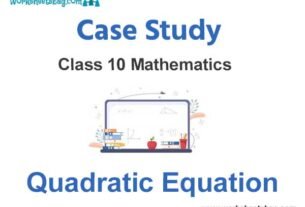Refer to Case Study Chapter 5 Arithmetic Progression Mathematics, these class 10 maths case study based questions have been designed as per the latest examination guidelines issued for the current academic year by CBSE, NCERT, KVS. Students should go through these solves case studies so that they are able to understand the pattern of questions expected in exams and get good marks.
Chapter 5 Arithmetic Progression Mathematics Case Study Based Questions
I. Your friend Veer wants to participate in a 200 m race. Presently, he can run 200 m in 51 seconds and during each day practice it takes him 2 seconds less. He wants to do in 31 seconds.
Question. Which of the following term is not in the AP of the above given situation?
(a) 41
(b) 30
(c) 37
(d) 39
Answer
B
Question. The value of x, for which 2x, x + 10, 3x + 2 are three consecutive terms of an AP is
(a) 6
(b) – 6
(c) 18
(d) –18
Answer
A
Question. Which of the following terms are in AP for the given situation?
(a) 51, 53, 55, …
(b) 51, 49, 47, …
(c) –51, –53, –55, …
(d) 51, 55, 59, …
Answer
B
Question. If nth term of an AP is given by an = 2n + 3 then common difference of an AP is
(a) 2
(b) 3
(c) 5
(d) 1
Answer
A
Question. What is the minimum number of days he needs to practice till his goal is achieved?
(a) 10
(b) 12
(c) 11
(d) 9
Answer
C
II. India is competitive manufacturing location due to the low cost of manpower and strong technical and engineering capabilities contributing to higher quality production runs. The production of TV sets in a factory increases uniformly by a fixed number every year. It produced 16000 sets in 6th year and 22600 in 9th year.
Question. In which year, the production is 29,200?
(a) 10th year
(b) 12th year
(c) 15th year
(d) 18th year
Answer
B
Question. The production during first year is
(a) 3000 TV sets
(b) 5000 TV sets
(c) 7000 TV sets
(d) 10000 TV sets
Answer
B
Question. The production during first 3 years is
(a) 12800
(b) 19300
(c) 21600
(d) 25200
Answer
C
Question. The difference of the production during 7th year and 4th year is
(a) 6600
(b) 6800
(c) 5400
(d) 7200
Answer
A
Question. The production during 8th year is
(a) 10500
(b) 11900
(c) 12500
(d) 20400
Answer
D
I. Pollution—A Major Problem: One of the major serious problems that the world is facing today is the environmental pollution. Common types of pollution include light, noise, water and air pollution.
In a school, students thoughts of planting trees in and around the school to reduce noise pollution and air pollution.
Condition I: It was decided that the number of trees that each section of each class will plant be the same as the class in which they are studying, e.g. a section of class I will plant 1 tree a section of class II will plant 2 trees and so on a section of class XII will plant 12 trees.
Condition II: It was decided that the number of trees that each section of each class will plant be the double of the class in which they are studying, e.g. a section of class I will plant 2 trees, a section of class II will plant 4 trees and so on a section of class XII will plant 24 trees.
Question. If there are two sections of each class, how many trees will be planted by the students?
(a) 422
(b) 312
(c) 360
(d) 540
Answer
B
Question. If there are three sections of each class, how many trees will be planted by the students?
(a) 234
(b) 260
(c) 310
(d) 326
Answer
A
Question. The AP formed by sequence i.e. number of plants by students is
(a) 0, 1, 2, 3, …, 12
(b) 1, 2, 3, 4, …, 12
(c) 0, 1, 2, 3, …, 15
(d) 1, 2, 3, 4, …, 15
Answer
B
Question. If there are three sections of each class, how many trees will be planted by the students?
(a) 468
(b) 590
(c) 710
(d) 620
Answer
A
Question. If there are two sections of each class, how many trees will be planted by the students?
(a) 126
(b) 152
(c) 156
(d) 184
Answer
C
II. Your elder brother wants to buy a car and plans to take loan from a bank for his car. He repays his total loan of ₹ 1,18,000 by paying every month starting with the first instalment of ₹ 1000. If he increases the instalment by ₹ 100 every month , answer the following:
Question. What amount does he still have to pay after 30th installment?
(a) ₹ 45500
(b) ₹ 49000
(c) ₹ 44500
(d) ₹ 54000
Answer
C
Question. The total amount paid by him upto 30 installments is
(a) ₹ 37000
(b) ₹ 73500
(c) ₹ 75300
(d) ₹ 75000
Answer
B
Question. The ratio of the 1st installment to the last installment is
(a) 1 : 49
(b) 10 : 49
(c) 10 : 39
(d) 39 : 10
Answer
B
Question. If total installments are 40, then amount paid in the last installment is
(a) ₹ 4900
(b) ₹ 3900
(c) ₹ 5900
(d) ₹ 9400
Answer
A
Question. The amount paid by him in 30th installment is
(a) ₹ 3900
(b) ₹ 3500
(c) ₹ 3700
(d) ₹ 3600
Answer
A



